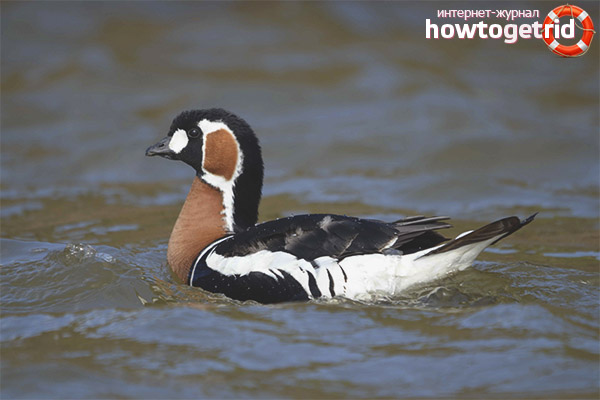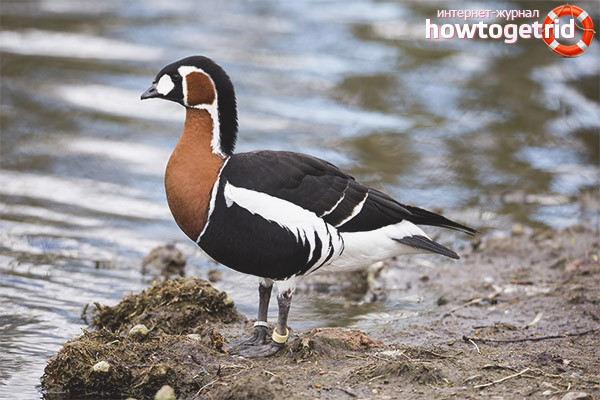The content of the article
Red-breasted geese can be attributed to species with a habitat in a certain narrow range. The number of these birds currently tends to be stable, although certain problems in this regard still remain. The fact is that people are actively developing those places that the bird chooses to molt.
According to the outlines, the bird resembles a small goose, on the body of which there is a bright plumage. But many parts of the body are black. On the head are rusty spots with small white inclusions. On the localization area of the goiter and the front of the neck there is a red color. Unlike the goose, nature awarded the bird with a small beak.
Prevalence
Bird nesting takes place in Altai Territory. The flight route from Taimyr Island passes through the Lower Ob and the Yenisei Guba. The final point is the mouth of the Irtysh River. The most common habitat of the Goose Goose is Lake Kulunda. Often she could be met there at the very beginning of autumn. Also the habitat is Pavlovsky and Peter and Paul region. This bird is found in different places along the Alei River. Sometimes its location is the Gilev Nature Reserve, which is located on the Upper Alley.
Habitat
Numbers
At present, the numerical composition of the population is marked by pronounced positive dynamics. Today, in the Altai Territory, you can meet individual loners in a goose flock. Now there is a small number of groups, which includes no more than 25 individuals, although in the past you could see a bird "team", where there were 50 or more representatives of this species. This situation, for example, could be observed in the area of Lake Kulunda, where the flock included 100 or more birds.
Lifestyle characterization
The wintering grounds of the Red-breasted Goose, like many other birds, are warm edges. In winter, birds move closer to the Black Sea. In native penates, the bird appears in the middle of the first month of summer. When September comes, she is already embarking on a journey to wintering places.
In its behavior, this bird is significantly different from other species. Noisiness and fussiness are the main signs of her behavior. The flight is characterized by speed and extreme mess. Noisy behavior in the air, the bird accompanies any event. Even in flight conditions, a rather loud communication of individuals among themselves is noted. It is interesting to observe the flight itself. The flock all the time shrinks, then breaks up.
This species is characterized by a daily lifestyle. During the day, the bird searches for food, which consists of plant components. In the afternoon, she can stop looking for food and go to a watering place. It uses leaves, rhizomes and shoots for food. In places where wintering takes place, the diet consists of winter cereals.
The bird spends a significant part of its daily time on water. They even spend the night on a pond, although this can be observed on land. Representatives of this species can swim and dive well enough. According to individual authors, representatives of this species can live up to 40 years.
Biological features

In the place of its future nesting bird appears in early summer. By this moment, they are already forming a held pair. In the second half of June, they begin to actively lay their eggs. The nesting colony is small in number, which includes no more than 5 pairs. Sometimes you can meet completely separate staves.
The bird reaches full puberty at the age of three years. Not every population practices nesting every year. Not more than 38% of its total composition take part in this. If the year is unfavorable, then this figure may amount to only 4%. Under normal conditions, the female lays up to 7 eggs. She will hatch them for 27 days. The male all this time is nearby on the coast or on the pond itself. The eggs are creamy with a light greenish tint.
The second half of July is marked by the appearance of downy chicks. During this period, individuals undergo postnuptial molting. When the chicks appear, they are taken by adult parents to a wet lawn. There they will be until the end of August. You can sometimes observe a picture in which several broods are combined into one common group. They resemble a kindergarten team. All the time, several old birds keep an eye on them.
The nest is located on a cliff next to its patrons, in the role of a peregrine falcon or seagull. It is not by chance that a bird chooses such a neighborhood. This serves as additional protection against the destruction of nests by predators, for example, arctic foxes. They will never hunt near birds of prey.
The bird begins to build its nest right after it arrives. They are open type, the basis of which is chosen the usual deepening of the cliff. Dry stalks of cereal crops are dragged to the bottom of the nest of the birds and lined with plenty of their own fluff. The nest is usually 20 cm in diameter and goes 5-8 cm deep.
For food, the bird uses exclusively plant food. Previously, the main place for wintering was represented by the territory belonging to the southern Caspian region. Now, for this purpose, the bird uses lake ponds of the west of the Black Sea region.
A regular breeding place for this species is Slimbridge, where the International Center for Waterfowl is located. The appearance of offspring could be observed in one of Moscow zoos.
Security measures
To this end, active educational work and control activities related to environmental legislation are underway. In connection with the real threat of the complete extinction of the species, the red-throated goose is in the Red Book of Russia. This species is under the protection of various international organizations. In this status, the bird appeared in connection with the threat of complete extinction. The second half of the last century was marked by a sharp decrease in its numbers. In the 70s of the last century, it fell by almost half.
Thanks to the active efforts of various organizations, there is now a tendency to stabilize the number of species. This bird is prohibited from any hunting.










Submit